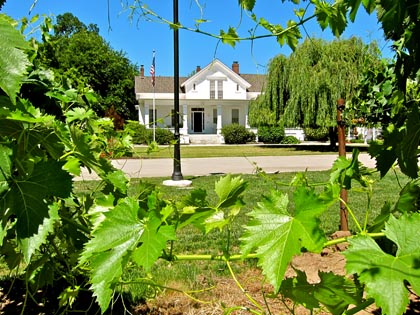Letters from Lodi
An insightful and objective look at viticulture and winemaking from the Lodi
Appellation and the growers and vintners behind these crafts. Told from the
perspective of multi-award winning wine journalist, Randy Caparoso.
Gotta revolution at Sorelle Winery
The Dodge House (est. 1866) at Sorelle Winery
Sorelle Winery prepares to release its first reserve bottlings
This past May Sorelle Winery bottled its first three reserve 2009s – a Primitivo, Sangiovese and Barbera – given nine months more aging in American oak (new and neutral) than Sorelle’s current releases, the 2009 Soriso Lodi Primitivo ($22), 2009 Troppo Bella Lodi Sangiovese ($23), and 2009 Belleza Fra Lodi Barbera ($25).
Our initial assessments of the reserves (scheduled for release in August): bellisima! Without going into detail (please see our tasting notes at the end of this post), let’s just say that the 2009 Reserve Primitivo is rounder, fleshier, and more velvety than the “regular” 2009 Primitivo, the 2009 Reserve Sangiovese is meatier and more elegantly composed than its original counterpart, and the 2009 Reserve Barbera is definitely a rounder, silkier rendering of this, the most food friendly of varietal red wines.
In a previous post, 2 sisters + 1 cool dad, we gave the basic lowdown on the phenomenal success of this new Lodi winery – still a few months from the anniversary of its inaugural releases – named for two sisters (hence, the Italian sorelle), Kim and Melissa, and co-run by their parents, Mike and Joanne Scott.
How do we spell success? Put it this way: Sorelle Winery is not just one more pretty, showy stop along the road, earnestly pouring mediocre wines for your sipping displeasure. This, in fact, is a winery that has already earned gold medals at the prestigious San Francisco Chronicle Wine Competition (January 2011) for its Sangiovese and Primitivo, and pleasing the Bay Area wine professionals manning this judging is no mean feat.
DAR plaque at The Dodge House
What this particular breed of wine judge seeks is wines of true focus, clarity and originality, in keeping with contemporary standards – like more purity of fruit expression as opposed to oak manipulation, wines of zesty rather than fat, tutti-fruity qualities, showing real sense of balance and finesse as opposed to being big, bombastic, inelegant statements.
These are the qualities that have defined Sorelle’s wines from the start. If you dig wines of purity, finesse, clarity and focus, we strongly encourage you to visit the Scotts’ tasting room on Hwy. 88 just south of Eight Mile Rd., which also happens to be an historic site officially marked by the Daughters of the American Revolution® (John C. Frémont and Kit Carson camped out here in 1825).
And yeah, it’s also a beautiful working winery; built in the same style as the historic Dodge House (est. 1866) and immaculately trellised garden of Sangiovese and Barbera vines that are visible from the highway. But for discriminating wine lovers, it really is what you taste in the bottles that count most.
Our tasting notes on the upcoming Sorelle reserves:
2009 Sorelle, Reserve Lodi Sangiovese – As with all three Sorelle reserves, the nine months of additional barrel aging has not resulted in an oakier tasting wine, but rather a wine that has picked up deeper, more viscous, flowing and fleshy dimensions. The flowery, sweet cherry perfume everyone’s loved in the initial release is still prevalent in this bottling; the oak veneer adding a lacy transparency that only emphasizes the delicacy and focus that originally made the Bay Area judges go gaga. Projected bottle price, around $27.
Kim and Mike Scott, assessing their reserves
2009 Sorelle, Reserve Lodi Primitivo – Interestingly enough, Mike Scott says that although initially enamored by Barbera, recently he has come to think of Primitivo as being his personal “favorite.” For the sake of vivication, the Primitivo grape is identical to Zinfandel in its DNA, but is a distinctive clone insofar as its evenly sized berries (whereas Zinfandel is famous for its “hens-and-chicks” sized berries which ripen unevenly, thus contributing to the multifaceted zesty/fat, soft/hard, lush/jammy berry qualities that people love in the grape). Sorelle’s Primitivo bottlings are no different – round, fleshy, fruit-forward, and not as jammy, wild or rambunctious as typical Lodi grown Zinfandel – yet the Sorelle reserve is all the more velvety and vibrant in the red berry (raspberry and black cherry) qualities, the extra barrel aging adding a tad more tannin to strengthen the wine’s grip on the palate, despite the soft, pliant feel typical of the varietal. Projected bottle price, about $28.
2009 Sorelle, Reserve Lodi Barbera – Whereas the original Sorelle Barbera is lean and tart edged – sensations people love in this wine – the Sorelle reserve seems to have gained a more layered, richly textured, silkier feel, rounding out the prickling acidity, and enhancing to the black cherry and roasted red meat qualities of the grape. Mr. Scott opined that the extra nine months in the barrel “seems to have made this wine taste fruitier, when you would think the opposite – that the original bottling, which saw less oak, would taste fruitier.” This is why, in fact, winemakers age wine in the barrel in the first place: not necessarily to make a wine taste oakier, but to take advantage of the oxidative process through which a wine’s fruit and terroir related characteristics can come into clearer, even brighter focus – like the handsome frame around a painting or photograph – while benefiting from the complexity that oak spices can contribute. About $30.
The Sorelle reserves




